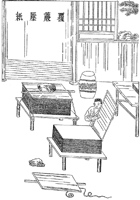History: Decoupage
Decoupage: The technique of decorating a surface with cutouts, as of paper
The earliest form of decorating with paper cutouts dates back to the twelfth century CE in Chinese peasant-art. This craft became known as découpage in France when it became increasingly popular during the seventeenth and eighteenth centuries. This technique most likely originated in Siberia when nomadic tribes would use cut out felts to decorate the tombs of their deceased. Then, the craft traveled to China where peasants used paper cutouts to decorate lamps, windows, boxes and other objects. During the seventeenth century when Italy became the forefront of trade with the Far East, the cut out paper decorations made their way to Europe. After its introduction in Italy, it quickly expanded to other European countries.

Decoupage involves gluing colored paper cutouts in combination with special paint effects, gold leafing, etc. onto an object. The paper is sealed with varnishes until the “stuck on” appearance disappears and looks like painting or inlay work. The varnish or lacquer (sometimes 30-40 layers) is sanded to a polished finish. This technique was an affordable alternative to the seventeenth century fashion for lacquered furniture. For this reason, it earned the name “poor man’s art.” Currently, decoupage is still a popular handicraft.
Timeline
| 3000 BCE | Egyptians began using papyrus pulp to make paper |
| 105 CE | Chinese court official Ts’ai Lun invented papermaking from textile waste using rags; this began a long tradition of painting, dying and sizing paper |
| 1041 CE | Bi Sheng invents movable type in China |
| 1100’s CE | Chinese peasants began using pasted paper to decorate small objects |
| 1450 CE | Johannes Gutenberg introduces the printing press |
| 1600’s CE | Trade between the Far East and Europe opens the exchange of decoupage techniques |
